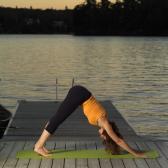
By Dr. Paul Jerard, E-RYT 500
Anyone who decides to become a Yoga teacher goes through many transformations, but your students will go through a variety of transformations, as well. The relationship between Yoga teacher and student is healthy because of the sharing of knowledge. Due to this constant sharing of ideas, the Yoga teacher and his or her students become healthier, wiser, and spiritually connected.
Yoga teacher transformations start from the moment you decide to become a Yoga teacher, but they continue as you decide to take a Yoga teacher training course. After the Yoga teacher certification process, most Yoga instructors continue to learn more about Yoga philosophy, anatomy, other forms of Yoga, meditation, Ayurvedic medicine, or any one of the many subjects that Yoga teachers would logically pursue.
However, teaching Yoga classes on a regular basis is a form of continuing education, as you learn to teach students with different bodies, minds, and health conditions. This is where many Yoga teachers go through a gradual transformation toward Samadhi. Samadhi is the ability to control functions of the mind and body, while eliminating life’s daily distractions from the goal of complete consciousness.
To anyone who has never studied Yoga this seems like “mission impossible.” Yet, Yoga instructors learn to “walk the talk” of Yogic philosophy. What, at one time, seemed like a lofty goal; can actually be realized gradually. This all stems from teaching, sharing knowledge, and becoming a living example of steady Yoga practice. This is not a mystery, but a path that all Yoga teachers should walk.
These changes of body, mind, and spirit do not happen instantly. Some Yoga teachers and serious Yoga practitioners will receive different benefits and reach different levels of Samadhi, as a result of steady practice.
Yoga student transformation can sometimes be more easily felt or seen. In fact, a new student, who has never practiced Yoga before, may find relief from head aches, hypertension, or a back ache within a few classes. This is not a guarantee, but it does happen often. When a student feels the physical or mental benefits of practice he or she becomes transformed by discarding pain and gaining new found enthusiasm.
Within any given Yoga class, there is a form of collective transformation that students and teacher experience. If you take a typical Hatha Yoga training session and consider the warm ups, Pranayama, Sun Salutations, asana practice, meditation, relaxation, or an integration of any other Yogic components; the transformation is quietly happening to the entire group.
There is no mystery here. Transformation of mind, body, and spirit is a result of steady Yoga practice.
© Copyright 2006 – Paul Jerard / Aura Publications
To see find out more about yoga or to see our selection of affordable courses, including our online hatha yoga teacher training programs, please use the yoga resources on the right side of this page.
If you are a teacher, yoga studio manager, blogger, e-zine, or website publisher, and are in need of quality content, please feel free to use my blog entries (articles). Please be sure to reprint each article, as is. Namaste!









